

How do nerve agents work? The science behind 'some of the most dangerous thin... The revelation that the major incident in Salisbury was the result of a nerve agent not only complicates the investigation and potential diplomatic effects.
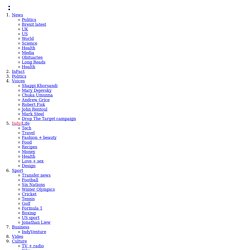
It also turns attention to nerve agents – an incredibly deadly, horrifying poison that until now has mostly been known for its role in battle. Nerve agents are a deadly poison, one that has until now been mostly considered to be a weapon of mass destruction. They are, according to one expert, "possibly some of the most dangerous things that humans have ever made, after the atom bomb". The science behind them demonstrates just how dangerous they can be for anyone who comes into contact with them, and difficult for the emergency services who treat them. Nerve agents are the mark of a sophisticated attack. They specifically attack the body's nervous system, forcing it into a painful and intense shutdown. But they all work on much the same principles. If someone is exposed to such an attack, it will become very clear very quickly. Red squirrel numbers boosted by predator - BBC News. Image copyright Tim Blackburn.
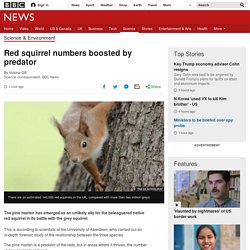
Mutation 'gives bats edge over deadly viruses' - BBC News. Image copyright SPL A single mutation in an immunity gene called Sting might be one reason why bats can resist the worst effects of harmful viruses such as Ebola.
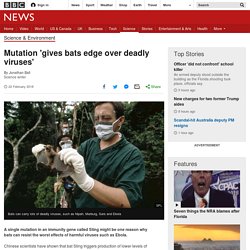
Chinese scientists have shown that bat Sting triggers production of lower levels of interferon, the proteins that signal when the body is under attack. Too much interferon is associated with the serious symptoms seen in many virus infections. But bats, through their mutation, have evolved a means to dampen the response. DNA clues to why woolly mammoth died out - BBC News. Image copyright SPL The last woolly mammoths to walk the Earth were so wracked with genetic disease that they lost their sense of smell, shunned company, and had a strange shiny coat.

That's the verdict of scientists who have analysed ancient DNA of the extinct animals for mutations. The studies suggest the last mammoths died out after their DNA became riddled with errors. The knowledge could inform conservation efforts for living animals. There are fewer than 100 Asiatic cheetahs left in the wild, while the remaining mountain gorilla population is estimated at about 300. Ginkgo 'living fossil' genome decoded. Image copyright Thinkstock The Ginkgo tree has had its genetic code laid bare by researchers.
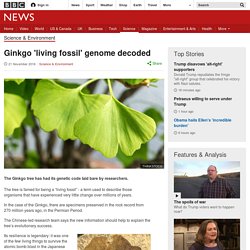
Genetic breakthrough: Crops use more sunlight to grow. Scientists have improved "the most important biological process on the planet" - photosynthesis.

The breakthrough, published in the journal Science, used genetic modification to increase the amount of sunlight energy crop plants can channel into food production. That increased yield in an experimental crop by 15%. Researchers say this is a critical step towards increasing crop production to feed a growing global population. CO2 levels mark 'new era' in the world's changing climate. First drug to reverse Huntington’s disease begins human trials. "It is very exciting to have the possibility of a treatment that could alter the course of this devastating disease," said clinical study principal investigator Dr Blair Leavitt, of the University of British Columbia in Vancouver.
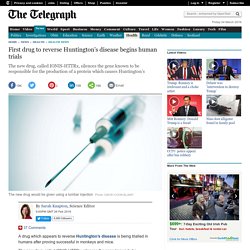
Scientists 'find cancer's Achilles heel' Image copyright SPL Scientists believe they have discovered a way to "steer" the immune system to kill cancers.

Researchers at University College, London have developed a way of finding unique markings within a tumour - its "Achilles heel" - allowing the body to target the disease. But the personalised method, reported in Science journal, would be expensive and has not yet been tried in patients. Experts said the idea made sense but could be more complicated in reality. However, the researchers, whose work was funded by Cancer Research UK, believe their discovery could form the backbone of new treatments and hope to test it in patients within two years. They believe by analysing the DNA, they'll be able to develop bespoke treatment. People have tried to steer the immune system to kill tumours before, but cancer vaccines have largely flopped. Study shows Zika 'might cause' Guillain-Barré syndrome. Your beard could help develop new antibiotics. Microbiologist Adam Roberts went digging through men’s beards in search of poop.
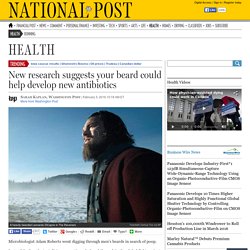
Instead, he found a tantalizing suggestion of a breakthrough in the global fight against drug-resistant infections. Which, for a researcher working fervently to help avert the antibiotic apocalypse that the World Health Organization, the director of the Centers for Disease Control and Prevention and Roberts himself believe may be looming, is not a bad trade off. The research began, as very few good things do, with a fake viral story from the Internet. If you have a beard or you’re currently kissing someone with a beard, or you simply have an affinity for gross stories about personal hygiene, you may remember the period in the spring when a slew of articles were published with headlines like, “Some beards contain more poo than a toilet shocking study reveals.” Harry How / GETTY / Getty Images"There is no plans or anything for it," Graham DeLaet said of his beard. Library and Archives Canada, Public Domain.
Bed-bug DNA scanned for vulnerabilities. Image copyright Louis Sorkin Scientists have sequenced the entire genome of the bed bug to help work out how to eliminate the pest, which has been developing resistance to existing insecticide sprays.
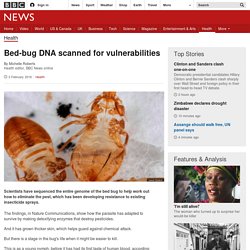
The findings, in Nature Communications, show how the parasite has adapted to survive by making detoxifying enzymes that destroy pesticides. And it has grown thicker skin, which helps guard against chemical attack. Scientists get 'gene editing' go-ahead. Image copyright SPL UK scientists have been given the go-ahead by the fertility regulator to genetically modify human embryos.
The promise of gene editing. Sharmila Nikapota, the mother of a child with a rare genetic disorder, has high hopes for gene editing. "For us this technology holds the unimaginable dream of a cure," she says. Her 13-year-old daughter Sohana has spent her entire life covered in painful blisters, the result of a condition called recessive dystrophic epidermolysis bullosa.
It is caused by two faulty collagen VII genes, which means her body does not produce the protein that helps anchor the skin in place. I first met Sohana a couple of years ago. Safer way to do gene editing. Image copyright SCIENCE PHOTO LIBRARY Scientists say they have fine tuned a gene editing method to make it safer and more accurate - vital if it is to be used in humans to cure inherited diseases or inborn errors. The advance, outlined in Science Magazine, comes as world leaders in the field gather to debate the ethics of altering human DNA using the method, known as Crispr-Cas9. Gene editing holds medical promise. But changing a person's DNA also has potential risks and ethical quandaries. Pancreatic cancer treatment 'breakthrough' - Ulster University. Image copyright Ulster University A new treatment for pancreatic cancer could significantly increase survival rates, Ulster University has claimed. It said the treatment could lead to a five-fold reduction in tumour size.
It involves injecting tumours with oxygen micro bubbles that are coated with a drug which is then activated by ultrasound. Oestrogen exposure can crash fish populations. Oestrogen, at levels common in municipal wastewater, can cause fish populations to crash. Self-sacrificing immune cells spew out DNA nets to trap invaders.
As well as carrying genetic instructions, it turns out DNA makes a handy weapon too. As a last-ditch defence against invading microbes, immune cells spew out sticky nets of their DNA. Four views: How can we save the rhino from poachers? Rhinos are in trouble. Snow leopards face 'new climate change threat' Image copyright ©naturepl.com/Reinhard/ARCO/ WWF Warmer temperatures are threatening to shrink the habitat of the snow leopard and weaken their struggle against extinction, a report says. Conservation charity WWF says more than a third of the animal's mountain living areas could become uninhabitable because of climate change.
Red meat cancer risk to be revealed by WHO. Explaining Elephants’ Cancer Resistance. Heart disease gene 'found in women' - oestrogen transcriptional factor. Image copyright SOUTHERN ILLINOIS UNIVERSITY/SCIENCE PHOTO LIBRARY Scientists have identified a gene that puts women at higher risk of heart disease, an early study suggests. Team wants to sell lab grown meat in five years. Immune clue to preventing schizophrenia. Young blood to be used in ultimate rejuvenation trial. First drug 'slows decline' in progressive MS - BBC News. Chemistry Nobel: Lindahl, Modrich and Sancar win for DNA repair. EFSA report considers risks of eating insects - BBC News. Fast-tracked skin cancer drug pembrolizumab gets approval - BBC News. The Ebola story. Leafcutter ants and their antibiotics. Rare 'healthy' smokers lungs explained - BBC News. Study supports cancer link with height - BBC News. Seaweed-coated cells save boy.
'Good bacteria' key to stopping asthma - BBC News. Can eating a curry help beat dementia? NOT drinking water. Stem cell trial aims to cure blindness - BBC News.